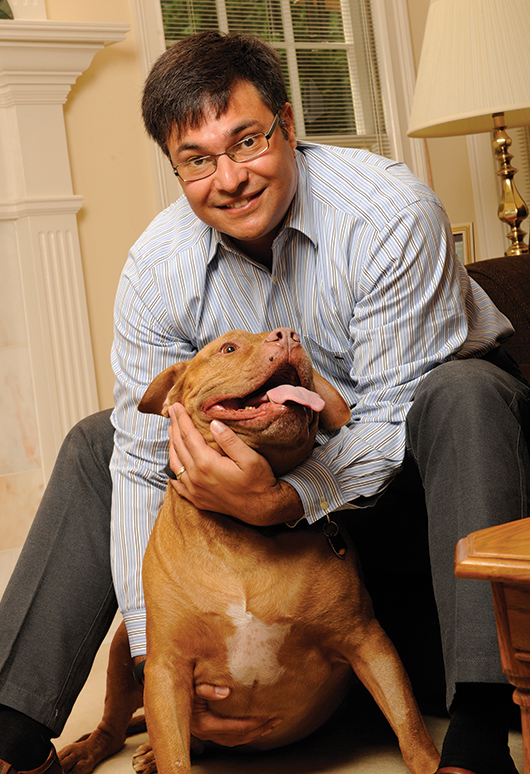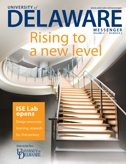
Cancer drug shows promise in canine patients
ALUMNI | For Petey and the other pit bulls like him, treatment begins in a “canine ER” at the University of Georgia.
The surgery itself takes a few hours: A portion of their naturally occurring brain tumor is removed and the malignancy confirmed. And then two palm-sized pumps, strapped to their necks like a collar, infuse a darkish brown fluid directly into the remaining tumor.
The dogs soon resume their normal lives, walking, eating, remaining largely unaware of the experimental cancer drug that, over the course of three days, targets an overgrowth of the epidermal growth factor receptor in their tumor.
The same receptor is overexposed in human cancers, and the drug, developed by neurosurgeon Costas G. Hadjipanayis, AS94, aims to slow it down.
In humans, the survival rate for patients with glioblastoma tumors is, at best, 12-15 months. In dogs, whose spontaneous glioma tumors develop and behave in remarkably similar ways, the life expectancy is typically no more than six months.
Petey, now 21 months post-surgery, has no evidence of tumor regrowth on his brain MRI. He is the cancer therapy’s most promising success story.
“We knew the treatment would be safe, but we had no idea the potential impact,” says Hadjipanayis, an assistant professor of neurosurgery at Emory University School of Medicine and chief of neurosurgery at Emory Hospital Midtown. “With these tumors, with fingers that infiltrate the brain, the challenge is always: How do you remove it all?”
His pioneering treatment offers one hopeful answer.
Hadjipanayis developed the experimental agent in his research lab at the Winship Cancer Institute of Emory University, attaching an iron-oxide magnetic nanoparticle to an FDA-approved antibody called cetuximab. The magnetic properties enable the drug to be directly imaged by MRI while, simultaneously, therapeutically targeting tumor cells.
In this extraordinary combination of physics and medicine, it’s perhaps unsurprising that the skilled neurosurgeon with a famous UD name often collaborates with the University’s internationally renowned physics professor George Hadjipanayis. The father-and-son team has worked in the past to develop new nanoparticles for targeted imaging and cancer therapies.
While they did not collaborate on this particular treatment, the junior Hadjipanayis credits his father for his scientific input and expertise. He also credits the University of Delaware, where he earned a bachelor’s degree in liberal studies and participated in the first class of the Medical Scholars Program with Jefferson Medical College, for an “excellent, innovative program to introduce me to medicine.” His wife of 16 years, Lorraine Hadjipanayis, is also a UD graduate.
Nearly 20 years later and now a specialist in surgical neuro-oncology, Hadjipanayis’ focus remains treating his brain cancer patients, almost all of whom know about Petey and the novel therapy he is testing.
“They constantly ask when we’ll move this to humans,” he says. “That’s certainly our goal, but we still have work to do.”
Hadjipanayis plans to submit an Investigational New Drug application to the FDA, a process that can take several years to complete. He is also co-investigator on an American Kennel Club grant that would expand testing to 15 other dogs with naturally occurring brain tumors.
Of the five terminal canine patients to receive the initial treatment, three have died. Still, their experiences offer a clearer picture of the safety and therapeutic efficacy of the experimental therapy.
For instance, Hadjipanayis has already seen the importance of precise catheter placement to target the tumor and visualize the nanoparticles. And, he has noticed no safety or toxicity issues with the drug infusion in all the dogs tested to date.
“These kinds of things help us understand how and what to improve on as we move forward for our new canine patients,” he says. “Or for our human patients, someday.”
In the meantime, Hadjipanayis is working on other cancer therapies to improve or prolong quality of life. He is the first U.S. neurosurgeon to test the European drug Gliolan, which patients ingest three hours prior to surgery. It then illuminates the tumor, distinguishing it from the normal brain tissue and enabling surgeons to more completely remove the malignant area.
“As a surgeon and as a researcher, my goal is always the same,” says Hadjipanayis. “I want to help my patients in any way I can.”
Article by Artika Casini, AS05






